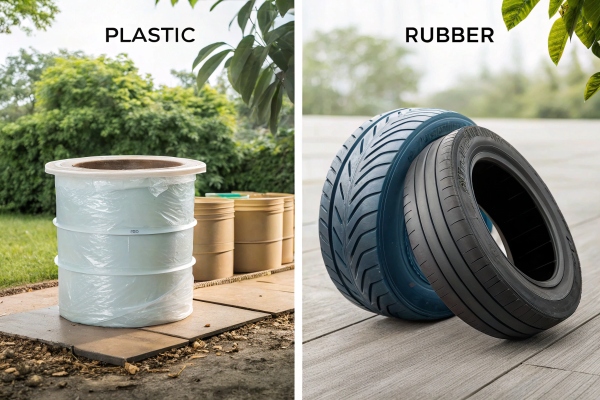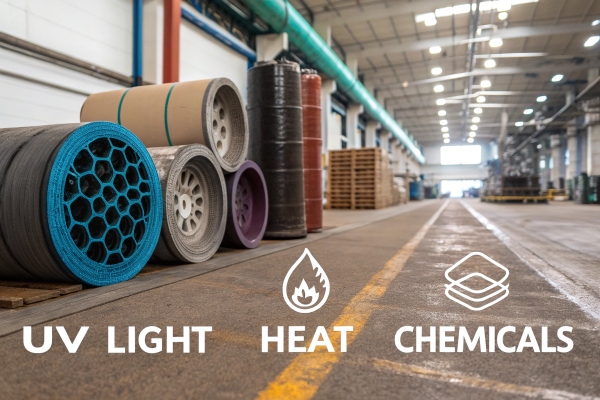Plastic and rubber are two of the most commonly used materials in the world. But what makes them different? Let's break down the key characteristics of each.
Plastic and rubber differ in their flexibility, durability, and environmental impact. Understanding these differences helps in choosing the right material for various applications. Learn more about plastic vs rubber1
Rubber and plastic each have their strengths and weaknesses. To decide which material to use, it’s important to consider how they compare in terms of lifespan, environmental impact, and practical applications.
Is Rubber Better Than Plastic?
Many people wonder whether rubber is a better choice than plastic. While both materials have their advantages, they also have their limitations.
In terms of flexibility, rubber outperforms plastic, but plastic is often more durable and cost-effective. Find out more about the pros and cons of plastic and rubber2
Durability and Flexibility
Rubber is more flexible and stretchable than plastic, making it ideal for seals, gaskets, and other applications that require flexibility. On the other hand, plastic is often more rigid, which makes it better suited for products like containers and packaging.
| Property | Rubber | Plastic |
|---|---|---|
| Flexibility | High, easily stretched and bent. | Low, generally rigid. |
| Durability | Resilient to wear and tear but degrades over time. | Highly durable, but can be brittle depending on type. |
| Applications | Automotive, medical devices, industrial seals. | Packaging, household goods, electronics. |
The choice between rubber and plastic depends on the specific needs of the application.
What is the Lifespan of Rubber?
How long does rubber last? The lifespan of rubber can vary depending on the type and how it is used.
Rubber has a finite lifespan, especially when exposed to UV light, heat, or harsh chemicals. However, with proper care, it can last for many years. Learn more about rubber lifespan3
Factors Affecting Rubber Lifespan
Several factors influence how long rubber lasts, including temperature, exposure to UV light, and chemical conditions. Rubber that is used outdoors or in harsh environments may degrade faster than rubber used indoors.
| Factor | Impact on Lifespan |
|---|---|
| Temperature | High temperatures can cause rubber to degrade faster. |
| UV Exposure | Prolonged exposure to sunlight can weaken rubber. |
| Chemical Exposure | Harsh chemicals can cause rubber to break down over time. |
Understanding these factors helps in choosing the right type of rubber for a particular environment.
What Lasts Longer, Rubber or Plastic?
When comparing the longevity of rubber and plastic, what material lasts longer? Both have unique properties that affect their lifespan.
Plastic is generally more durable than rubber, but it is more susceptible to cracking and breaking under stress. Rubber, on the other hand, is more resilient to wear but may degrade due to environmental factors. Read more about rubber vs plastic durability4
Comparing Durability
While plastic may last longer in certain conditions, rubber is often the better choice for products that require flexibility or resilience. The environment plays a large role in determining which material will last longer.
| Material | Durability | Longevity in Harsh Conditions |
|---|---|---|
| Rubber | Resilient, but susceptible to UV damage and heat. | Lasts well under compression and in flexible applications. |
| Plastic | More durable, but can crack under stress. | May break down when exposed to extreme conditions or UV light. |
The decision on which material lasts longer depends largely on the specific environmental conditions.
Why Haven't We Banned Plastic?
Plastic is everywhere, but why haven’t we been able to ban it despite its environmental impact?
Plastic’s persistence in society is due to its versatility, low cost, and durability. However, its environmental effects cannot be ignored. Learn why banning plastic is difficult5
The Challenges of Banning Plastic
Plastics are inexpensive and extremely versatile, which is why they are so widely used. Despite the environmental damage caused by plastic waste, its low cost and convenience make it difficult to phase out.
| Challenge | Explanation |
|---|---|
| Versatility | Plastic can be molded into countless shapes and forms. |
| Cost | Plastics are often cheaper to produce than alternatives. |
| Waste Management | Recycling plastic is difficult and often not done effectively. |
Banning plastic is a complex issue that involves considering alternatives and the global demand for inexpensive materials.
How Does the Environmental Impact of Rubber Compare to That of Plastic?
Both rubber and plastic have significant environmental impacts. But which one is more eco-friendly?
Rubber is biodegradable, but it is not free from environmental concerns. On the other hand, plastic is non-biodegradable and contributes significantly to pollution. Find out more about the environmental impact of rubber and plastic6
Comparing Environmental Footprints
While plastic takes centuries to break down, rubber biodegrades over time. However, rubber production requires significant resources, and its environmental footprint can still be considerable.
Environmental Impact Comparison
| Criteria | Rubber | Plastic |
|---|---|---|
| Source | Natural rubber is derived from rubber trees; synthetic rubber is made from petroleum | Primarily derived from petrochemicals, a non-renewable resource |
| Biodegradability | Natural rubber is biodegradable; synthetic rubber is not | Most plastics are non-biodegradable and can take hundreds to thousands of years to decompose |
| Pollution | Natural rubber contributes less to pollution; synthetic rubber can contribute to microplastic pollution | Significant contributor to environmental pollution, especially in oceans and waterways |
| Production Impact | Natural rubber production can be sustainable if managed properly; synthetic rubber production involves harmful extraction processes | Plastic production generates greenhouse gases and other pollutants; improper disposal leads to widespread environmental harm |
| Recycling | Rubber can be recycled, but the process may be energy-intensive; recycling rates are improving for tires | Recycling is possible but often inefficient; a large percentage of plastic waste is not recycled |
| Ecosystem Effects | Decomposing rubber can leach harmful chemicals into soil and water if not disposed of properly | Microplastics are pervasive in ecosystems and have been found in marine life and human organs, raising health concerns |
Key Insights
-
Natural Rubber: Considered more environmentally friendly due to its renewable source and biodegradability. It does not require deforestation for harvesting since trees can continue producing latex for many years without being cut down. However, the cultivation of rubber trees requires significant land and water resources.
-
Synthetic Rubber: While it provides durability and specific performance characteristics, its production relies on fossil fuels, contributing to carbon emissions and environmental degradation. Additionally, synthetic rubber is not biodegradable, leading to long-term pollution issues.
-
Plastics: Widely recognized for their negative environmental impact, plastics contribute significantly to pollution due to their non-biodegradable nature. They can persist in the environment for centuries, affecting wildlife and ecosystems. The production of plastics also contributes to greenhouse gas emissions.
In conclusion, while both materials have environmental impacts, natural rubber is generally seen as the more sustainable option compared to synthetic rubber and plastic. The choice between these materials should consider their lifecycle impacts, biodegradability, and potential for recycling.
Conclusion
The choice between rubber and plastic depends on the application, lifespan, and environmental impact. Both have unique advantages and limitations.
Footnotes:
-
Understanding the differences between plastic and rubber helps in choosing the right material for various industrial and commercial applications. ↩
-
Exploring the pros and cons of rubber and plastic can help clarify which material is better suited for specific needs. ↩
-
The lifespan of rubber depends on factors like temperature and chemical exposure. With proper care, rubber can last many years. ↩
-
Plastic may be more durable than rubber, but rubber is better for flexible applications and is more resilient in certain conditions. ↩
-
The persistence of plastic in modern society is due to its low cost and versatile uses, despite its negative environmental impact. ↩
-
While rubber is biodegradable, plastic poses a greater long-term environmental challenge due to its non-biodegradable nature. ↩











